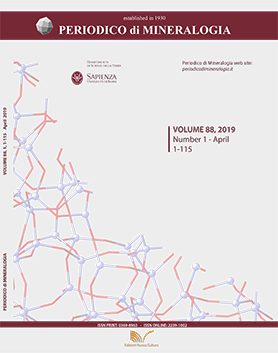Fluid inclusion and C and O stable isotopes in hydrothermal calcite from the Gharkohneh iron deposit, NE Iran
DOI:
https://doi.org/10.2451/2019PM803Keywords:
Hematite, Goethite, Fluid inclusion, C and O stable isotopes, Gharkohneh, NE Iran.Abstract
The Gharkohneh stratabound iron deposit is located in the southern Binaloud zone, northeast of Iran. This deposit occurred as lenses, veins/veinlets, and layers of iron oxides and hydroxides within the Devonian carbonates. The main opaque minerals are hematite and goethite, accompanied by lesser amounts of pyrite and magnetite. The hydrothermal calcite is the most important gangue mineral, principally containing liquid-rich 2-phase inclusions, which homogenize into liquid state. The δ13C (PDB) and δ18O (SMOW) values of calcite range from -2.5‰ to -8.2‰, and +19.2‰ to +21.4‰, respectively, which are similar to the host carbonates. The C and O isotopic composition of calcite in the host carbonates has become lighter relative to those of the normal Devonian marine carbonates during the formation of iron ores.
The microthermometric and isotopic data revealed that the Gharkohneh iron deposit was formed as the result of interaction between the hydrothermal fluids and the host carbonates at moderate temperatures (~200°C) in an open system. Pyrite and magnetite have been formed by metasomatic replacement of the host carbonates. In contrast, hematite and goethite have been developed during the supergene alteration under oxidizing conditions. Certain convincing evidence such as intimate association of mineralization with fault breccia zone, hydrothermal alteration, and lack of massive sulfide-type and Mn-rich ores in the area suggest that the iron deposit in Gharkohneh is of stratabound-type, developed by both hypogene and supergene processes.


